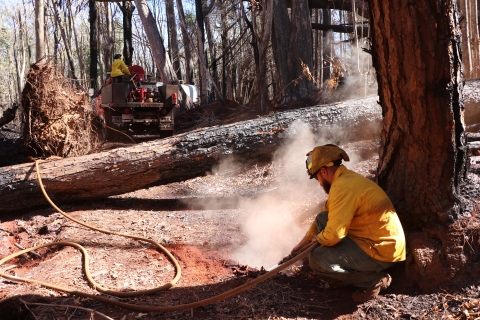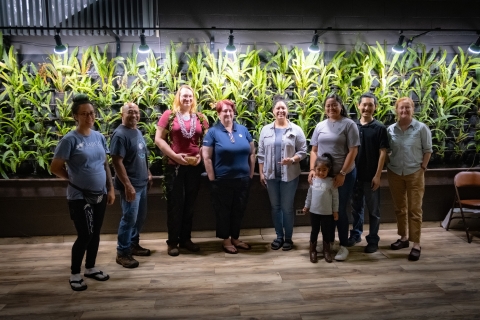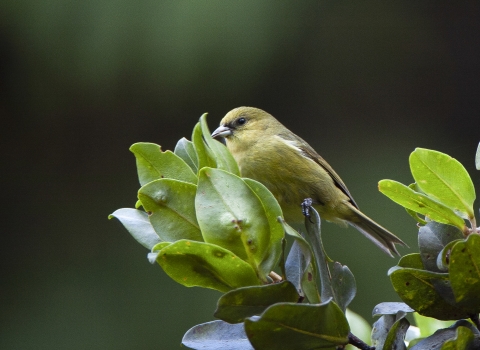Partnerships are the backbone of conservation because it truly takes a community to save a single species. The Hawaiian Islands are home to many species in need of saving. Coined the “Endangered Species Capital of the World,” Hawaiʻi accounts for 490 species protected by the Endangered Species Act. Because of this, many federal, state, and partner agencies work in tandem to bolster the impact of resources and workforce efforts across the islands. It is a partnership that is invaluable beyond words.
The unique and iconic forest birds of Hawaiʻi are at the center of such a partnership. Once represented by more than 50 species of forest birds, only 17 remain with many on the very brink of extinction. In 2021, the U.S. Department of the Interior (DOI) developed a multi-agency, comprehensive strategy to protect the iconic Native Hawaiian forest birds and identified the effort as one of the DOI’s 10 Keystone Initiatives. Building upon strong and meaningful partnerships, the Keystone Initiative has committed significant federal resources, including $33.2 million of Bipartisan Infrastructure Law Bipartisan Infrastructure Law
The Bipartisan Infrastructure Law (BIL) is a once-in-a-generation investment in the nation’s infrastructure and economic competitiveness. We were directly appropriated $455 million over five years in BIL funds for programs related to the President’s America the Beautiful initiative.
Learn more about Bipartisan Infrastructure Law and Inflation Reduction Act funds.
The Maui Bird Conservation Center (MBCC) is a captive care and breeding facility for Hawaiʻi’s critically endangered forest birds. Sitting at 4,000 feet on the slope of Haleakalā, MBCC encompasses 46 acres and is managed by the San Diego ZooWildlife Alliance in cooperation with the U.S. Fish and Wildlife Service (Service) and the Hawaiʻi Department of Land and Natural Resources–Division of Forestry and Wildlife (DOFAW).
The MBCC houses four species of endemic forest birds, including ʻalalā and ‘akikiki, species that are functionally extinct in the wild, as well as kiwiku and palila, whose numbers are dwindling in the wild. All four species are important representatives of the natural heritage of the Hawaiian Islands and are culturally significant to the Native Hawaiian community. Established in 1996, the structure structure
Something temporarily or permanently constructed, built, or placed; and constructed of natural or manufactured parts including, but not limited to, a building, shed, cabin, porch, bridge, walkway, stair steps, sign, landing, platform, dock, rack, fence, telecommunication device, antennae, fish cleaning table, satellite dish/mount, or well head.
Learn more about structure the houses the MBCC was once a low security prison but has since evolved into a lifeline for these endangered species.
A testament to how important these species are is the dedication shown by the people who work beside them.
On the morning of August 8, 2023, Jennifer Pribble, a wildlife care supervisor at MBCC, awoke to high winds and falling trees. When she went outside to assess the situation, she noticed flames across the road from the MBCC facility. Shifting winds pushed the flames across the narrow road and onto the edges of the MBCC property – less than 50 yards from some of the bird aviaries. Pribble, who was in constant contact with the DOFAW fire management team, notified them of the imminent threat and used fire extinguishers and a water hose to contain the flames that jumped the road. At that time, DOFAW fire management team was finishing the containment of a fire in Kahalui, 17 miles north of the facility. Within 45 minutes after receiving the call from Pribble, DOFAW fire management team were on site to fight the fire and would remain there for several weeks to keep the shifting wildlife from crossing over the narrow road.
“At the end of the fire you look back and it’s all worth it,” said Lance DeSilva, DOFAW Maui Forestry Program manager. “We enjoy what we do. Everything that we did, no regrets. Everything that we did we feel proud of. We worked 18-to-20-hour shifts and as you get tired you realize this is a lot of work, but you realize what is benefiting from it. It’s all worth it.”
The Service acknowledged the courage of their partners by recognizing those who selflessly protected the endangered forest birds in a private ceremony held at the MBCC. The staff and firefighting crew were awarded “The Department of the Interior’s Citizens Award for Exceptional Service” which recognizes outstanding performance by a private citizen, organizational partner, or volunteer who has contributed significantly to the Bureau's mission. This award also recognizes the collaborative partnership held by everyone involved with saving Hawaiʻi’s forest birds.
“We don’t know what’s going to come so we just have to be prepared for anything,” said Pribble. “It’s just an honor to be able to get this award just because I got to play a part in saving these species once again. We’re doing so much to save these species so they can be released in the wild. And natural disaster is just an additional threat to these birds, and I got to play my role.”










